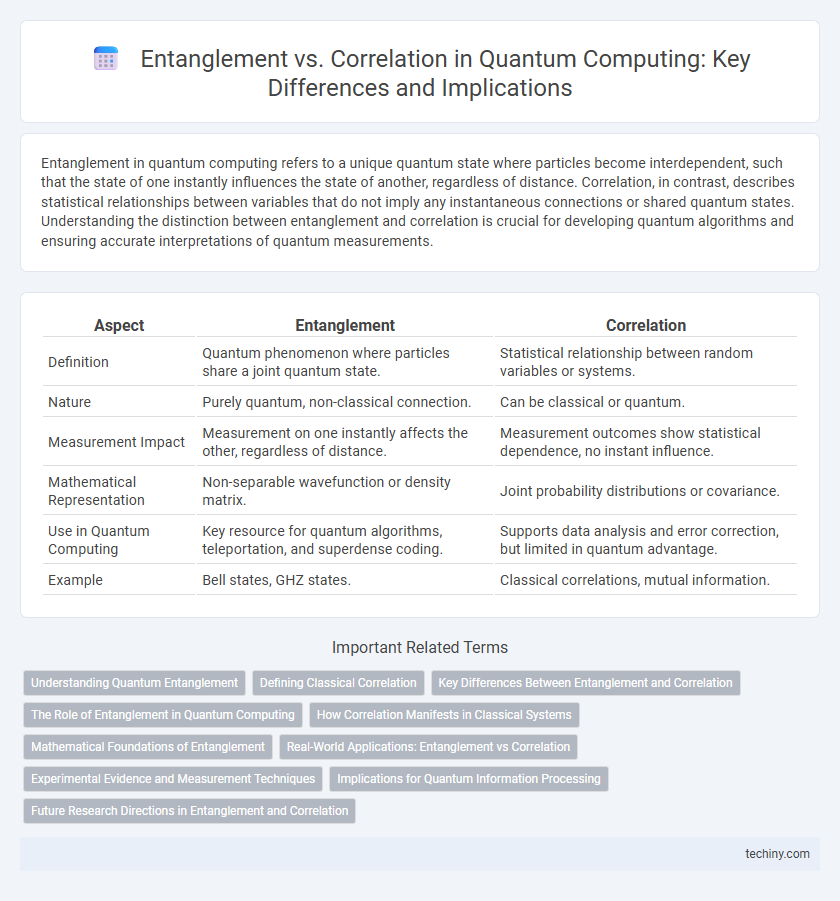Entanglement in quantum computing refers to a unique quantum state where particles become interdependent, such that the state of one instantly influences the state of another, regardless of distance. Correlation, in contrast, describes statistical relationships between variables that do not imply any instantaneous connections or shared quantum states. Understanding the distinction between entanglement and correlation is crucial for developing quantum algorithms and ensuring accurate interpretations of quantum measurements.
Table of Comparison
| Aspect | Entanglement | Correlation |
|---|---|---|
| Definition | Quantum phenomenon where particles share a joint quantum state. | Statistical relationship between random variables or systems. |
| Nature | Purely quantum, non-classical connection. | Can be classical or quantum. |
| Measurement Impact | Measurement on one instantly affects the other, regardless of distance. | Measurement outcomes show statistical dependence, no instant influence. |
| Mathematical Representation | Non-separable wavefunction or density matrix. | Joint probability distributions or covariance. |
| Use in Quantum Computing | Key resource for quantum algorithms, teleportation, and superdense coding. | Supports data analysis and error correction, but limited in quantum advantage. |
| Example | Bell states, GHZ states. | Classical correlations, mutual information. |
Understanding Quantum Entanglement
Quantum entanglement is a distinct phenomenon where particles become interconnected such that the state of one instantaneously influences the state of another, regardless of distance, unlike classical correlation which involves shared information without instantaneous linkage. Entanglement plays a crucial role in quantum computing, enabling qubits to perform complex computations and secure communication through quantum teleportation and superdense coding. Understanding the non-local, inseparable nature of entangled states is fundamental to leveraging quantum algorithms and advancing quantum information science.
Defining Classical Correlation
Classical correlation refers to the statistical relationship between variables that can be explained by shared information or common causes within classical physics frameworks. Unlike quantum entanglement, classical correlation does not involve nonlocal connections or the superposition of states, but rather relies on pre-existing properties and deterministic or probabilistic dependencies. Understanding classical correlation is essential for distinguishing it from quantum phenomena in quantum computing and information theory.
Key Differences Between Entanglement and Correlation
Entanglement in quantum computing involves a non-classical link between quantum states where the state of each particle cannot be described independently, unlike classical correlation which pertains to statistical dependencies between variables without such inseparability. Entangled particles exhibit correlations stronger than those possible by any classical mechanism, enabling quantum phenomena like superposition and Bell inequality violations. While correlation can exist without entanglement, entanglement implies a deeper, inseparable quantum connection crucial for quantum algorithms and quantum information processing.
The Role of Entanglement in Quantum Computing
Entanglement serves as a fundamental resource in quantum computing, enabling qubits to exhibit correlations that classical systems cannot replicate. This unique quantum correlation allows for enhanced computational power in algorithms like Shor's and Grover's, facilitating tasks such as factorization and unstructured search with exponential speedups. Unlike classical correlations, entanglement produces non-local effects essential for quantum error correction, teleportation, and secure communication protocols within quantum networks.
How Correlation Manifests in Classical Systems
In classical systems, correlation manifests as statistical dependencies between variables, where the state of one variable provides information about another without implying any intrinsic connection. These correlations arise from common causes or direct interactions and are described by classical probability theory. Unlike quantum entanglement, classical correlations cannot exhibit nonlocality or violate Bell inequalities, limiting their role in computational advantages.
Mathematical Foundations of Entanglement
Entanglement is mathematically characterized by non-separable quantum states in Hilbert space, where the joint state cannot be expressed as a product of individual subsystem states, contrasting classical correlation represented by joint probability distributions. The density matrix formalism reveals entanglement through non-factorizable matrices, captured by measures such as the concurrence or entanglement entropy. These mathematical foundations enable quantifying entanglement's unique non-local properties that surpass classical correlation limits in quantum computing algorithms.
Real-World Applications: Entanglement vs Correlation
Entanglement in quantum computing enables non-classical correlations essential for quantum cryptography, quantum teleportation, and superdense coding, offering security and communication advantages unattainable by classical correlation. Correlation, while present in classical systems, lacks the non-local link strength of entanglement, limiting its application in advanced quantum algorithms and error correction protocols. Real-world applications leverage entanglement for quantum key distribution (QKD) and entanglement-based sensors, demonstrating performance beyond classical correlation limits.
Experimental Evidence and Measurement Techniques
Entanglement in quantum computing is experimentally distinguished from classical correlation through Bell test experiments, where measurement outcomes violate Bell inequalities, confirming nonlocal quantum correlations. Advanced measurement techniques like superconducting qubits readout and photonic entanglement detection use coincidence counting and state tomography to verify entangled states with high fidelity. These methods provide robust evidence that entanglement enables quantum information processing beyond classical correlated systems.
Implications for Quantum Information Processing
Entanglement enables non-classical correlations between quantum systems, serving as a fundamental resource for quantum information processing tasks such as quantum teleportation and superdense coding. Unlike classical correlation, entanglement allows for the creation of inseparable quantum states that enhance computational speed and security in quantum communication protocols. Exploiting entanglement improves error correction techniques and paves the way for advances in quantum cryptography and quantum algorithms.
Future Research Directions in Entanglement and Correlation
Future research in quantum entanglement focuses on developing scalable entanglement distribution protocols to enhance quantum network efficiency and robustness. Investigations into correlation measures aim to refine the quantification of quantum resources, facilitating improved error correction and quantum algorithm optimization. Emerging studies explore hybrid approaches combining entanglement and classical correlations to advance practical quantum communication and computation systems.
Entanglement vs Correlation Infographic

 techiny.com
techiny.com